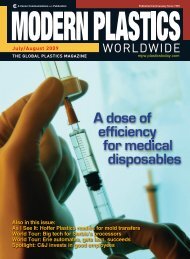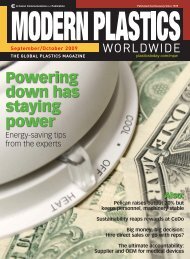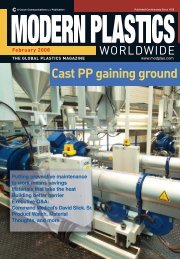Modern Plastics Worldwide - March 2010 - dae uptlax
Modern Plastics Worldwide - March 2010 - dae uptlax
Modern Plastics Worldwide - March 2010 - dae uptlax
Create successful ePaper yourself
Turn your PDF publications into a flip-book with our unique Google optimized e-Paper software.
EXTRUSION<br />
whether they are coming in with<br />
the resin or are created in the process.<br />
The best way to find this out<br />
is to run the virgin resin through a<br />
clean, small extruder. It’s virtually<br />
impossible for gels to form from<br />
clean resin in just a few minutes.<br />
Thus, if the product comes out<br />
with gels from the beginning, and<br />
the gel content stays more or less<br />
the same for a while, they are in<br />
the resin and you have a good case<br />
for rebate or refund if it was sold<br />
to you as clean. There is even a<br />
machine on the market that blows<br />
film and counts “discontinuities<br />
per square meter of surface” to<br />
quantify gel content.<br />
You can also get the same<br />
answer on production machinery,<br />
but it is less precise. If the gels don’t<br />
appear for a while, maybe a few hours or even a few shifts, and<br />
the material and conditions stay the same, it’s likely that they are<br />
forming in the system, most likely the adapter and die in places<br />
where the melt is moving most slowly (large diameters, sharp<br />
bends). Formulation matters: Some processing aids coat the<br />
inside of the flow paths and discourage gel formation, as well as<br />
reduce backpressure and thus allow lower melt temperature.<br />
Resins vary in thermal stability, too, and less-stable materials<br />
will degrade faster into gels and (eventually) black or brown<br />
particles. Running a small product (low mass rate) in a large<br />
machine will contribute to this, as the melt must move more<br />
slowly and stay hot longer. If the gels start as soon as the suspected<br />
resin is used and stay relatively constant, they are in the feed.<br />
You can, of course, have both things going on at once, where<br />
there are plenty of gels in the incoming resin, but after a while<br />
you are adding to them by degrading materials in the head/die.<br />
Q: Which of the screw segments or zones is very important?<br />
AG: They are all important, of course, but the one I was referring<br />
to as special was the rear (first) barrel zone. In this zone,<br />
unlike the others, the barrel wall is not fully coated with melt,<br />
but is still usually well above the melt temperature of the plastic,<br />
so the particles can stick to the barrel as needed for good<br />
“inpush.” Grooved-barrel extruders, typically used for HDPE<br />
film, are an exception; the particles slip on the barrel but only<br />
in the forward direction, but that zone is still independently<br />
important.<br />
I try to separate this rear zone from the others so that people<br />
will consider it alone, or perhaps combined with #2 in a long<br />
extruder with five or six zones, rather than move all the settings<br />
up or down in unison. There is an optimum setting of<br />
zone #1, not necessarily the hottest or the coldest, where the<br />
sticking is best—any hotter and the particles melt on contact<br />
and slide around self-lubricated, and inpush starts to fall off.<br />
Figure 1. The screw-cooling fitting on the rear of the<br />
extruder wobbled back and forth with each revolution,<br />
showing the count, but the loose fit stressed the<br />
connections.<br />
This optimum will vary with the<br />
resin, with the feed temperature,<br />
and with the screw speed, so it<br />
really is best found by “trial and<br />
success,” and I am thus skeptical<br />
of any proposed settings that<br />
are alleged to apply to any one<br />
material in all cases.<br />
The rear barrel temperature<br />
is also the “aspirin” of the troubleshooter—it’s<br />
what you change<br />
if you don’t really know what else<br />
to do, especially when processing<br />
semicrystalline polymers. I<br />
have seen it resolve problems of<br />
surging, excess pressure, or melt<br />
temperature and air entrapment,<br />
and wouldn’t be surprised to hear<br />
other stories, including some in<br />
which it made things worse.<br />
Q: How and why does overheating HDPE make it stronger?<br />
AG: When any polymer is heated, there is some chain breakage.<br />
As might be imagined, the hotter the temperature and the<br />
longer the time at that temperature, the more the degradation.<br />
However, there is also a cross-linking and chain-growing reaction<br />
that takes place where the loose, broken ends of a molecule<br />
look for and find places on some other chain to attach.<br />
This makes that molecule larger and stronger and compensates<br />
for the weakening effect of chain breakage. In the case of some<br />
HDPE grades, the viscosity actually increases (equivalent of<br />
melt index decrease). But this can’t go on indefinitely, because<br />
the breakage is normally inhibited by antioxidant in the formulation,<br />
which is consumed as the melt remains at the high<br />
temperature, and eventually is used up. After that, the breakage<br />
occurs faster than the cross-linking and the viscosity starts to<br />
fall again, representing a weakening effect.<br />
I was involved in these experiments many years ago, when<br />
we were trying to show that the use of “scrap” HDPE pipe<br />
did not necessarily weaken the pressure pipe made from such<br />
a mixture. We ran several HDPEs in a torque rheometer for<br />
up to an hour, far longer than the usual residence time in an<br />
extruder, and sure enough, the torque (measure of viscosity)<br />
What’s a webinar?<br />
Many of you know already that a webinar is a seminar held<br />
via the Internet. Here’s how we do it. We limit them to 60<br />
minutes. They are a free source of information. Our goal in<br />
each webinar is to provide plastics processors with information<br />
they can use to improve their business (not coincidentally, the<br />
goal of this magazine, too).<br />
During the webinar, you hear the presenter but cannot speak<br />
to him (imagine 250 people around the world talking at once<br />
on the same phone line). As an attendee you can submit your<br />
questions via an instant messaging-type service. Questions are<br />
answered during the event or via e-mail soon thereafter.<br />
34 MARCH <strong>2010</strong> • MODERN PLASTICS WORLDWIDE plasticstoday.com/mpw









